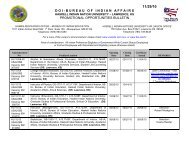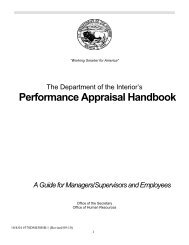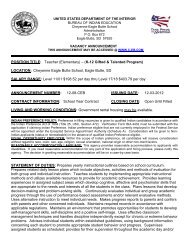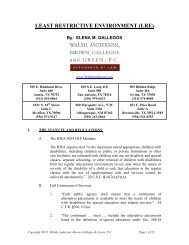BIE 2009-2010 Baseline Data Report Kingsbury-NWEA - Bureau of ...
BIE 2009-2010 Baseline Data Report Kingsbury-NWEA - Bureau of ...
BIE 2009-2010 Baseline Data Report Kingsbury-NWEA - Bureau of ...
- No tags were found...
You also want an ePaper? Increase the reach of your titles
YUMPU automatically turns print PDFs into web optimized ePapers that Google loves.
RECOMMENDATIONSAfter analyzing the performance data for the <strong>2009</strong>-<strong>2010</strong> school year, we have the following recommendations for the<strong>Bureau</strong> <strong>of</strong> Indian Education.We recommend that the <strong>Bureau</strong> continue to look closely at its student performance data on a regular basis.<strong>NWEA</strong> provides achievement and growth reports to <strong>BIE</strong> after each term. These interactive reports provide <strong>Bureau</strong>leaders as well as ADD, ELO, and school leaders a way to look at student data to find areas <strong>of</strong> success and areas <strong>of</strong>concern. This printed report shows at a high level how <strong>BIE</strong> students are doing in a variety <strong>of</strong> areas, but doesn’t takethe place <strong>of</strong> teachers and students looking at their data together throughout the year to create pathways forprogress.We recommend that the <strong>Bureau</strong> undertake further analysis in areas not pursued in this report.There are areas <strong>of</strong> analysis not included in this report or included only minimally that could provide additionalinformation. For instance, disaggregation by schools receiving pr<strong>of</strong>essional development showed a difference butthe types <strong>of</strong> pr<strong>of</strong>essional development received were studied. More analysis would be needed to understandwhether the particular type <strong>of</strong> pr<strong>of</strong>essional development has an effect for students. In addition, an area <strong>of</strong> researchnot included in this report is summer loss: whether growth gained by students during the year is sustained over thesummer months into the next school year. Research in the field <strong>of</strong> education has shown that many students inpoverty situations have more loss over the summer than students in affluent situations, meaning that thesestudents stay further behind despite significant school year growth.We recommend that the <strong>Bureau</strong> continue to monitor progress on an annual basis for several years, and thencommission a program evaluation study including at least three years <strong>of</strong> student performance.This report serves as the first in what we recommend is a series <strong>of</strong> reports on the progress <strong>of</strong> <strong>BIE</strong> schools. With oneyear <strong>of</strong> testing data, some differences were able to be identified, but more years <strong>of</strong> data deepens the analyses andallows for the identification <strong>of</strong> trends and progress. Intervention strategies <strong>of</strong>ten take several years for results to beseen at a high level, so a multi-year evaluation is necessary to reflect the result <strong>of</strong> <strong>Bureau</strong> changes. <strong>NWEA</strong> can workwith the <strong>BIE</strong> to identify an appropriate organization to provide such an evaluation.We recommend that the <strong>Bureau</strong> use their data to ask difficult questions about student performance andschool programs.This report and the “roll up reporting” provided every term gives <strong>BIE</strong> an opportunity to ask questions about whethertheir current interventions are working, and where they might need more interventions. For instance, in generalgrowth for <strong>BIE</strong> students was better in Math than Reading—was this due to a particular intervention? Could studentsbenefit from the same type <strong>of</strong> intervention in Reading? Why do students in different ELOs show such differentgrowth? Are there best practices that could be shared among <strong>BIE</strong> schools? What is driving the strong growth for highschool students?33 | P a g e
















